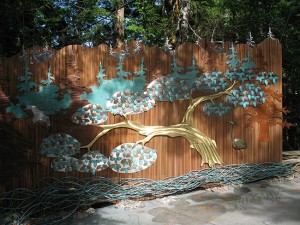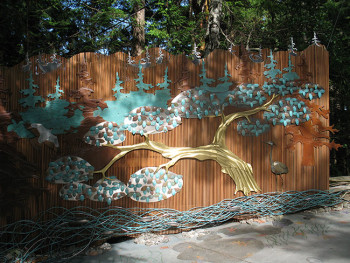— by Cara Russell —
 Located on Olga Road, and looking out over the waters of East Sound, The Lambiel Museum catches the eye, yet remains a mysterious place to many who drive past it every day. The 12-foot-tall steel castle mailbox and the iron Orca whale fence, created by Orcas artist Todd Spalti, just scratch the surface of the treasure behind the ancient Egyptian doors that lead inside.
Located on Olga Road, and looking out over the waters of East Sound, The Lambiel Museum catches the eye, yet remains a mysterious place to many who drive past it every day. The 12-foot-tall steel castle mailbox and the iron Orca whale fence, created by Orcas artist Todd Spalti, just scratch the surface of the treasure behind the ancient Egyptian doors that lead inside.
This museum, which also doubles as Leo Lambiel’s home, houses an extensive collection of art exclusively by artists from the San Juan Islands. “As far as I know, I’m the only person who is collecting local art,” said Leo. “The purpose of the museum is to house, preserve, and display the best pieces by the best artists who live or have ever lived in the San Juan Islands.”
Leo moved to Orcas Island when he was 21 years-old. He knew then that the San Juan Islands are a special place that attracts artists. Leo’s love for collecting art began slowly; buying a few pieces at first, then a few more, and so on. Now, nearly 50 years later, his collection has grown to such proportions that not only has he had to build more rooms to his home to hold it all, but the guided tours he personally offers take nearly two hours!
Lambiel owns between 800-900 pieces, from about 230 local artists, the earliest dating back to 1915. The local art consists of paintings, drawings, etchings, sculptures, murals, glasswork, photography, and ceramics. The art is exhibited in two buildings and throughout the property. There is an underground grotto, outdoor sculptures, a Grecian Temple ruin, a collection of rare Persian rugs, antique Grandfather Clocks, and the world’s largest collection of Helen Loggie. “It’s not possible for anyone else to make a collection like this. It doesn’t happen overnight, and it takes a long time,” said Leo.
During the summer months the museum receives upwards of 900 visitors. Many are returning customers, bringing more people with them each time they visit. Skagit Valley College also sponsors large groups that bus in 35-40 people at a time. Leo believes that the museum of local art draws more visitors to the island.
Though the collection has been steadily growing over the last fifty years, recently Leo has become concerned with its state of uncertainty. “I’m not going to live forever, and I need to start making plans for the future of the museum, and the collection,” said Leo. Though he has always thought he would donate the entire collection, as well as the real estate, to a local non-profit, he is unsure that will be the future for the collection.
Currently Leo is in discussion with Western Washington University, which could result in a portion of the collection going to Bellingham, the property being sold, and the balance of the art being scattered all over. WWU is interested in the Helen Loggie collection. While Leo has the largest collection of Helen Loggie in the United States, WWU has the second largest collection.
“I think that the art should stay in the community, stay together, and continue to grow. But I’m getting older, and I want to have it organized,” said Leo. “Ultimately, I’m trying to assess if people care, and if they even know that this museum exists. My questions is, is it important to Islanders that such a large collection of local art stay in our community And does the community want it?”
If you are interested in a tour of the Lambiel Museum, call 376-4544 to make an appointment for the tour. The museum is open daily by appointment only. The two-hour guided tours are by donation.
**If you are reading theOrcasonian for free, thank your fellow islanders. If you would like to support theOrcasonian CLICK HERE to set your modestly-priced, voluntary subscription. Otherwise, no worries; we’re happy to share with you.**









The Lambiel Museum is part of the charm of Orcas Island.
Unfortunately some islanders may take this treasure for granted.
Let’s not let this slip away from us!
Over the years working at various lodging business on Orcas I’ve sent many people to see Leo’s collection – most of them came back very impressed. We have taken our guests there, too. The county has harassed him for various things – unfairly I feel. They should be grateful for a beautiful and wonderful collection. I hope Leo’s valuable collection can stay on Orcas.
Lose the Lambiel Museum? Unthinkable! The Museum is an Island treasure! So many talented SJ Islands Artist’s work displayed in such a beautiful place!
It is my hope that an established non-profit could step in or a new non-profit can be established. This would save the whole collection (including Helen Logge’s work) as well as the property and buildings which are works of art too! I say, “Yes”! Let’s do it!
Spirit Eagle, Artist